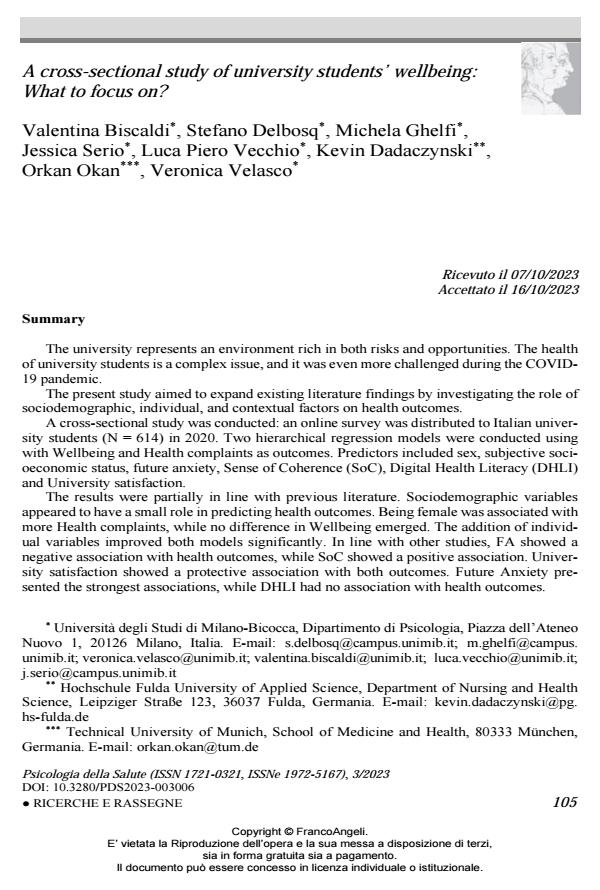A cross-sectional study of university students’ wellbeing: What to focus on?
Titolo Rivista PSICOLOGIA DELLA SALUTE
Autori/Curatori Valentina Biscaldi, Stefano Delbosq, Michela Ghelfi, Jessica Serio, Luca Piero Vecchio, Kevin Dadaczynski, Orkan Okan, Veronica Velasco
Anno di pubblicazione 2023 Fascicolo 2023/3
Lingua Inglese Numero pagine 20 P. 105-124 Dimensione file 256 KB
DOI 10.3280/PDS2023-003006
Il DOI è il codice a barre della proprietà intellettuale: per saperne di più
clicca qui
Qui sotto puoi vedere in anteprima la prima pagina di questo articolo.
Se questo articolo ti interessa, lo puoi acquistare (e scaricare in formato pdf) seguendo le facili indicazioni per acquistare il download credit. Acquista Download Credits per scaricare questo Articolo in formato PDF

FrancoAngeli è membro della Publishers International Linking Association, Inc (PILA)associazione indipendente e non profit per facilitare (attraverso i servizi tecnologici implementati da CrossRef.org) l’accesso degli studiosi ai contenuti digitali nelle pubblicazioni professionali e scientifiche
The university represents an environment rich in both risks and opportunities. The health of university students is a complex issue, and it was even more challenged during the COVID-19 pandemic. The present study aimed to expand existing literature findings by investigating the role of sociodemographic, individual, and contextual factors on health outcomes. A cross-sectional study was conducted: an online survey was distributed to Italian univer-sity students (N = 614) in 2020. Two hierarchical regression models were conducted using with Wellbeing and Health complaints as outcomes. Predictors included sex, subjective socio-economic status, future anxiety, Sense of Coherence (SoC), Digital Health Literacy (DHLI) and University satisfaction. The results were partially in line with previous literature. Sociodemographic variables appeared to have a small role in predicting health outcomes. Being female was associated with more Health complaints, while no difference in Wellbeing emerged. The addition of individual variables improved both models significantly. In line with other studies, FA showed a nega-tive association with health outcomes, while SoC showed a positive association. University satisfaction showed a protective association with both outcomes. Future Anxiety presented the strongest associations, while DHLI had no association with health outcomes. This confirmed the literature’s findings that different factors can influence university stu-dents’ wellbeing and that universities can have an important role in promoting it.
L’università rappresenta un ambiente ricco di rischi e opportunità. La salute degli studenti universitari è una questione complessa, messa ancor più a dura prova dalla pandemia COVID-19. Il presente studio si proponeva di ampliare i risultati della letteratura esistente indagando il ruolo dei fattori sociodemografici, individuali e contestuali sugli esiti di salute. È stato condotto uno studio trasversale: un questionario online è stato distribuito nel 2020 a studenti universitari italiani (N=614). Sono stati condotti due modelli di regressione gerar-chica utilizzando come esiti il benessere e i sintomi psicosomatici. I predittori includevano: sesso, stato socioeconomico soggettivo, ansia del futuro, senso di coerenza (SoC), Digital Health Literacy (DHLI) e soddisfazione universitaria. I risultati sono parzialmente in linea con la letteratura precedente. Le variabili sociodemo-grafiche sembrano avere un ruolo limitato nel predire i risultati di salute. Il sesso femminile è stato associato a un maggior numero di sintomi psicosomatici, mentre non è emersa alcuna differenza per il benessere. L’aggiunta di variabili individuali ha migliorato significativamente entrambi i modelli. In linea con altri studi, l’Ansia del futuro è associata negativamente ai risul-tati di salute, mentre il SoC ha mostrato un’associazione positiva. La soddisfazione universita-ria è associata positivamente a entrambe le dimensioni. L’ansia del futuro ha presentato le as-sociazioni più forti, mentre la DHLI non risulta associata ad alcun esito di salute. Questo studio conferma i risultati della letteratura sul fatto che diversi fattori concorrono nell’influenzare il benessere degli studenti universitari e che l’università può avere un ruolo importante nel promuoverlo.
Parole chiave:benessere, studenti universitari, soddisfazione, senso di coerenza, COVID-health literacy network.
Valentina Biscaldi, Stefano Delbosq, Michela Ghelfi, Jessica Serio, Luca Piero Vecchio, Kevin Dadaczynski, Orkan Okan, Veronica Velasco, A cross-sectional study of university students’ wellbeing: What to focus on? in "PSICOLOGIA DELLA SALUTE" 3/2023, pp 105-124, DOI: 10.3280/PDS2023-003006